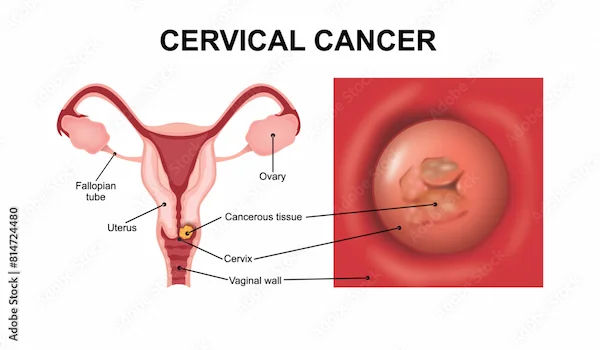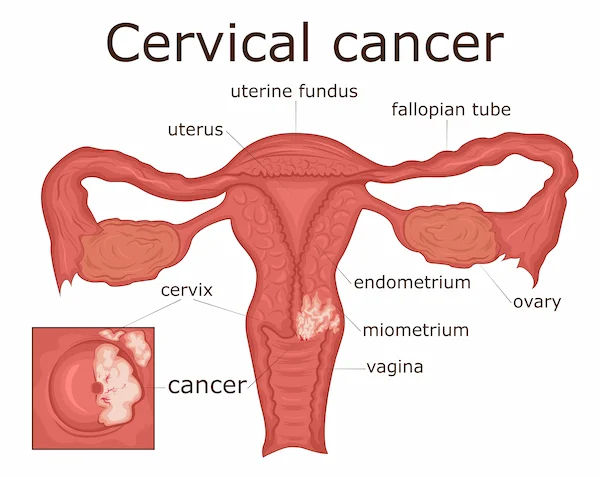Cervical Cancer: Causes, Symptoms and Treatment
Learn about cervical cancer, including its causes, signs, common symptoms, and treatment options. Understand prevention strategies and the importance of early detection for better outcomes.

Written by Dr Sonia Bhatt
Last updated on 3rd Jul, 2025
Cervical cancer is a major global health challenge, particularly for women in low and middle-income countries. Advances in medical science have enabled early detection, and prevention, which have contributed to a lowering of mortality rates for this disease.
Cervical cancer begins in the cervix, the lower, narrow part of the uterus that opens into the vagina. Most cases develop slowly as precancerous conditions and time may see them progress.
Read below about the causes, symptoms, prevention, and treatment of this condition.
Causes and Risk Factors
Cervical cancer is a multifactorial disease. Nearly 99 percent of the women who develop cervical cancer are infected with human papillomavirus (HPV). Among the most high-risk strains, HPV-16 and HPV-18 can infiltrate cervical cells, where they lead to uncontrolled mutation and possibly cervical cancer.
Other risk factors include:
Effects of Smoking: Passive smoking increases risk by damaging cervical cells.
Genetic Susceptibility: Cervical cancer is more likely to occur in people who are genetically predisposed to it.
Oral Contraceptives and Childbirth: The use of oral contraceptives for a long period and multiparity are associated with an increased risk of cervical cancer.
Weakened Immune System: Persons who are HIV (human immunodeficiency virus) positive, or those receiving certain medications have an increased risk of HPV infection and cervical cancer, especially if they have a weakened immune system.
Obesity and Screening Challenges: Obesity makes cervical cancer screenings more difficult, resulting in decreased detection of precancerous conditions and a greater risk of disease.
Signs and Symptoms
Different symptoms of cervical cancer may occur at different stages of the disease.
1. Early symptoms of cervical cancer include unusual vaginal bleeding, characterised by:
Bleeding after sex
Bleeding between periods
Bleeding after menopause
Menstrual periods which are very heavy or frequent that last for several days
2. Changes in vaginal discharge may present as:
Water
Discharge with a very strong odour
Blood in the discharge
3. Pelvic discomfort is reported, including:
Painful sexual intercourse
Pain that is localised in the lower back, pelvis, or lower abdomen
Patients can have symptoms including bowel issues, painful urination, weight loss, and leg swelling. Signs of advanced cervical cancer include pain during sex, unusual bleeding, and foul-smelling discharge, and should be dealt with promptly.
Consult Top Oncologist
Screening and Diagnosis
The Pap smear test is used as a screening method to detect precancerous and abnormal cervical cells, an important tool for gynecological health. It is recommended for women from age 21 to help identify potential problems early enough to intervene.
An important tool for screening and diagnosing cervical cancer is human papillomavirus (HPV) test, including high-risk HPV types associated with the disease. Speculum or a supervised self-collection is used to collect cervical cell samples.
A biopsy may be done to find abnormalities during screening and to confirm cervical cancer. The different ways of sampling the cervical tissue include :
Punch biopsy, where a small circular piece is excised
Endocervical curettage, cellular collection from the cervical canal
Loop electrosurgical excision procedure using electrical currents
Large cone-shaped specimen removal requires general anaesthesia for cone biopsy
Stages of Cervical Cancer
The spread of cervical cancer is graded according to extent in each stage to guide treatment decisions and prognosis. Stages of cervical cancer are as follows:
Stage I: This type is limited to the cervix.
Stage II: Cancer is limited to the cervix but not to the pelvic wall nor the lower third of the vagina.
Stage III: Cancer spreads to the pelvic wall or involves nearby lymph nodes.
Stage IV: Cancer can spread to other organs in the body, like the lungs or liver.
The survival rate of early-stage cervical cancer is 91%. The rate falls to 60% if the cancer has spread to adjacent tissues or lymph nodes. For distant metastasis, the survival rate is only 19%. The overall survival rate for all cervical cancer patients stands at 67%.
Treatment Options
The treatment for cervical cancer may vary from one stage to another and depends not only on the stage but also on individual factors. Therapy is usually a combination of several modalities.
1. Surgical options include:
Conization: To remove an area of abnormal tissue that resembles a cone.
Hysterectomy: Sometimes, removal of the uterus is necessary for invasive cancer.
Lymphadenectomy: Removal of lymph nodes to check if the cancer has spread.
Radical Trachelectomy: Used for stage 1 cervical cancer, a procedure that removes most of the cervix but allows for potential pregnancy.
Loop Electrosurgical Excision Procedure (LEEP): Technique that involves the use of a thin, low-voltage wire to obtain a small tissue sample.
Lymph Node Dissection: Pelvic lymph node removal is a procedure done to remove lymph nodes when filled with cancerous cells, usually in stages 1 and 2 and above cervical cancer.
2. Cervical cancer management is largely dependent upon radiotherapy, using high-energy x-ray. It consists of external beam radiation therapy, intensity-modulated radiotherapy, and brachytherapy. Radiotherapy allows for a targeted treatment while at the same time dealing with adverse effects that arise from an intervention.
3. Administration of cisplatin in combination with non-platinum chemotherapeutics often increases efficacy and improves patient outcomes.
Prevention Strategies
The HPV vaccine prevents cervical, vaginal, and vulvar cancers caused by most types of HPV. The Gardasil and Cervarix vaccines remain effective for at least 10 years after receiving the vaccine and 6 years after receiving the Gardasil 9 vaccine.
Routine Pap smears and HPV testing are important, since changes may be precancerous. According to guidelines, screening should occur every three to five years based on age and medical history.
Lifestyle and Management
A healthy diet high in fruits, vegetables, and whole grains can help to strengthen the immune system. Antioxidant rich foods such as berries and leafy greens help combat cellular damage.
There are many ways to manage side effects of cervical cancer treatment, including:
Fatigue: Fatigue can be combated by regular light exercise and a good rest.
Nausea: This side effect is managed using small, frequent meals, and anti-nausea medications.
Emotional Well-being: Cancer treatment can cause emotional problems that support groups and counselling can help you with.
Conclusion
Cervical cancer remains a serious health concern, but with early detection, preventive measures, and advancements in medical treatment, it is both preventable and treatable. By staying informed, getting regular screenings, and utilising available support systems, individuals can significantly reduce the risk and impact of this disease, leading to better health outcomes and improved quality of life.
Consult Top Oncologist
Consult Top Oncologist

Dr. Sanchayan Mandal
Medical Oncologist
17 Years • MBBS, DNB Raditherapy, DrNB Medical Oncology
East Midnapore
VIVEKANANDA SEBA SADAN, East Midnapore

Dr. Sanchayan Mandal
Medical Oncologist
17 Years • MBBS, DrNB( MEDICAL ONCOLOGY), DNB (RADIOTHERAPY),ECMO. PDCR. ASCO
Kolkata
MCR SUPER SPECIALITY POLY CLINIC & PATHOLOGY, Kolkata

Dr.sanchayan Mandal
Medical Oncologist
17 Years • MBBS, DrNB( MEDICAL ONCOLOGY), DNB (RADIOTHERAPY),ECMO. PDCR. ASCO
Kolkata
Dr. Sanchayan Mandal Oncology Clinic, Kolkata

Dr Sunita Samleti
Oncologist
18 Years • M.D. (Pathology)- TN Medical College, Mumbai University, Mumbai, Mar 2005 M.B.B.S. Grant Medical College, Mumbai University, Mumbai, Oct 1999
Chinagadila
Apollo Hospitals Health City Unit, Chinagadila

Dr Gowshikk Rajkumar
Oncologist
10 Years • MBBS, DMRT, DNB in Radiation oncology
Bengaluru
Apollo Clinic, JP nagar, Bengaluru
Consult Top Oncologist

Dr. Sanchayan Mandal
Medical Oncologist
17 Years • MBBS, DNB Raditherapy, DrNB Medical Oncology
East Midnapore
VIVEKANANDA SEBA SADAN, East Midnapore

Dr. Sanchayan Mandal
Medical Oncologist
17 Years • MBBS, DrNB( MEDICAL ONCOLOGY), DNB (RADIOTHERAPY),ECMO. PDCR. ASCO
Kolkata
MCR SUPER SPECIALITY POLY CLINIC & PATHOLOGY, Kolkata

Dr.sanchayan Mandal
Medical Oncologist
17 Years • MBBS, DrNB( MEDICAL ONCOLOGY), DNB (RADIOTHERAPY),ECMO. PDCR. ASCO
Kolkata
Dr. Sanchayan Mandal Oncology Clinic, Kolkata

Dr Sunita Samleti
Oncologist
18 Years • M.D. (Pathology)- TN Medical College, Mumbai University, Mumbai, Mar 2005 M.B.B.S. Grant Medical College, Mumbai University, Mumbai, Oct 1999
Chinagadila
Apollo Hospitals Health City Unit, Chinagadila

Dr Gowshikk Rajkumar
Oncologist
10 Years • MBBS, DMRT, DNB in Radiation oncology
Bengaluru
Apollo Clinic, JP nagar, Bengaluru




